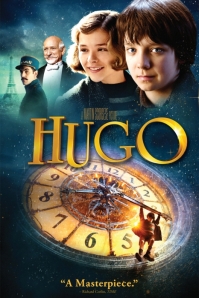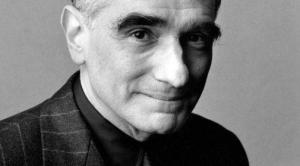Early cinema history in Hugo
Hugo is an adaptation of the graphic novel The Invention of Hugo Cabret by Brian Selznick. Martin Scorsese and screenwriter John Logan create extra storylines or fill in the backstory of characters who make minor appearances in the book because it adds more fully to the film’s impact, but in many ways, the film uses the book’s images as a blueprint. Scorsese’s film brings to life the illustrations of the mechanical man and Hugo peering out from the clock.
In addition to being Scorsese’s first venture into family movies, Hugo is Scorsese’s love letter to the magic of cinema and to some of the pioneers in the field. Of course, the figure of Papa Georges is based on the story of French filmmaker Georges Méliès, but there are nods to inventors and film pioneers such as the Lumière Brothers, Thomas Edison, and Edwin S. Porter, as well as to some of the first Hollywood Stars, such as Buster Keaton, Douglas Fairbanks, Harold Lloyd, Charlie Chaplain, Rudolph Valentino, Mary Pickford, and Tom Mix. (The scene where the Station Inspector, played by Sacha Baron Cohen, is dragged by the train is very much in the vein of Buster Keaton or Charlie Chaplin.) It is important to note the film’s acknowledgement of the international roots of early cinema in the West.
Scorsese is not the only filmmaker who pays visual tribute to his predecessors–Tim Burton and Quentin Tarantino both make films that are full allusions to the movies and filmmakers that have influenced them. For example, Frankenweenie has gags and characters that are based on classic horror movies such as Frankenstein, The Bride of Frankenstein, Creature from the Black Lagoon, and Godzilla. Having a little knowledge of the history of cinema will make your viewing of their movies much more enjoyable.
This film and many of the others we’ll watch this semester try to evoke a specific era. In Hugo, there are nods to popular culture of the day with writer James Joyce and musician Django Reinhardt taking part in the café life at the station. While knowing these figures is not crucial for understanding Hugo, spotting them and knowing their role in early 20th century culture (both helped usher in Modernism to some degree–Joyce’s stream-of-consciousness was a relatively new form as was Reinhardt’s jazz guitar playing) makes the viewing experience more fun.
Scorsese knows his film history and layers it into the storyline of Hugo, enhancing Georges Méliès’ contributions to film as one of the first filmmakers to experiment with special effects and discovering the jump cut, and Scorsese also givies viewers a quick overview of the beginnings of the film industry. Scorsese does a lot of work for film restoration and preservation projects as well as movie history projects. He is a director who never forgot his childhood love of the movies, as he reveals in this Lucasfilm interview. The story of Méliès’ financial ruin and the destruction of many of his films addresses some of the concerns about film preservation while the scene where Hugo and Isabelle sneak into the movies shows the power movies can have on the viewer.
Hugo captures the early days of filmmaking and movie going in scenes where Papa Georges and film professor Rene Tabard (Michael Stuhlbarg) talk about the transition of Méliès’ career from a stage magician to one of the first auteurs of cinema.
Many of the early experiments with cameras and film technology were done in Europe (especially France); American inventor Thomas Edison saw the potential of moving pictures as an entertainment source and put money into developing not only the equipment for making and showing movies, but also in developing them as a narrative device instead of simply another way to document the world. Very early films were simply movies of people going about their business and do not have a true storyline, but Edison, Méliès, and a few others started considering ways to use film to tell a story, building studios and experimenting with editing film to create a narrative arc through visual cues.
In America, most of the early movie stars came out of the studios in Hollywood and Hollywood became known across the globe as place where movies and dreams were made.
About some of the techniques used in Hugo
Even though Hugo is marketed as a family movie, it has all of the touches that make it a Martin Scorsese movie The film’s establishing shot takes the viewer swooping in over Paris, through the train station, up the tower to Hugo’s face peering out at the world below sets the tone for the film. It is simultaneously in past and present—the set is a recreation of early 20th century Paris done in loving detail (and based in part on Méliès’ shots of the same area of Paris), but the filming technique uses the latest technology (the film was shot for 3-D viewing using the newest cameras and editing software).
The final scene of the film shot by Larry McConkey is one long Steadicam shot, which is a technique Scorsese uses to great effect in other films such as Goodfellas and many similar tracking shots appear in Mean Streets, such as the one where cinematographer Kent Wakeford’s camera follows Charlie (Harvey Kietel) into the bar as he greets the other patrons and then takes the stage with the dancers. The painterly use of color and the soundtrack that is used as a secondary storytelling device are also similar to Scorsese’s other films. The pops of color, such as the blue in the Station Guard’s uniform and the flower stand in Hugo are reminiscent of the hand-tinting Méliès put to use in his films where only some elements in a frame were colored.
Scorsese is also known for casting relative unknowns in major parts. Both of child actors Asa Butterfield (Hugo) and Chloe Grace Moretz (Isabelle) had a couple of big budget film experiences before being cast in Hugo. Similarly, Cathy Moriarity and Joe Pesci were cast in Raging Bull without having “name recognition.” Pesci had been ready to give up on his acting career when he got the call from Scorsese to play Jake LaMotta’s (Robert DeNiro) brother Joey.
Scorsese once said in an interview that he is fascinated with violence and people who are angry. While Hugo does not have the outright violence of Goodfellas or Taxi Driver, nor the seething anger underlying Raging Bull, there are plenty of reminders that the world is not fair or full of nice people. Many of the adults in Hugo’s world are angry, violent, or unreasonable. Hugo’s alcoholic uncle, the station inspector, and at times both Papa Georges and bookseller Monsieur Labisse are all figures who threaten and scare Hugo. His uncertain status as child fending for himself is a constant source of anxiety in the film: Hugo witnesses the chase, capture, and arrest of a fellow orphan and nearly suffers the same fate.
A note on Scorsese’s crew
Scorsese gets his films to have a signature look and feel through close working relationships with some of the best in their fields, such as film editor Thelma Schoonmaker and visual effects experts Rob Legato and Ben Grossman. Hugo’s distinctive look was a team effort. Mike Seymour’s article, Hugo: A study of Modern Inventive Visual Effects has a great overview of how Hugo was filmed.
Film terminology for the week
Jump cut: an abrupt, disorienting transitional device in the middle of a continuous shot in which the action is noticeably advanced in time or cut between two similar scenes. This might be done accidentally (a technical flaw or the result of bad editing) or purposefully (to create discontinuity for artistic effect). Georges Méliès discovered the jump cut by accident and then incorporated it into his films as a special effect.
In this scene from Breathless, Jean Luc Goddard uses the jump cut to imply the length of the car ride.
Parallel editing or cross cutting: alternating two or more scenes that are usually happening simultaneously but in different locations. Edwin S. Porter is often credited with first using parallel editing.
An early example from the 1920 film Way Down East, directed by D. W. Griffith
A more modern example from The Godfather, 1972, directed by Francis Ford Coppola
Steadicam shot: a hand-held camera technique using a stabilizing Steadicam (introduced in the late 70s), developed by inventor Garrett Brown, with a special, mechanical harness that allows the camera operator to take relatively smooth and steady shots, though hand-held, while moving along with the action; the resulting images are comparable to normal tracking shots on a wheeled dolly
Scene from Goodfellas where the Steadicam is used:
Next week we’ll talk about American comedies and Love Crazy.



The author has a website: The Invention of Hugo Cabret http://www.wired.com/underwire/2012/01/pixomondo-hugo-vfx/
Thank you for adding that link. The amount of time and money that went into the making of the film is mind-boggling.
I absolutely loved it sitting in a theater watching all the historical magic of movies. It was a lovely film.
The pacing might have been a little slow for some, but I found it added a dreamlike quality to the movie. I’m a Scorsese fan, though, and usually give his movies a couple of viewings before I can digest them.
Did you happen to see it in 3-D?